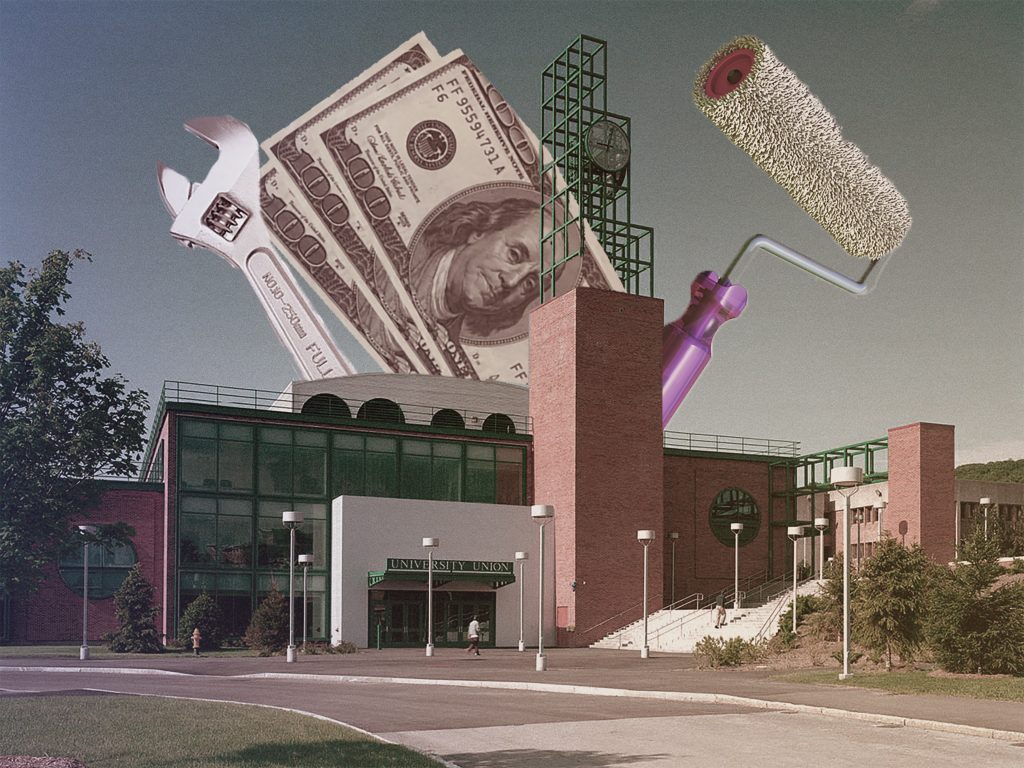With the many barricades and newfangled updates in the University Union, it’s hard to ignore the changes being made to the central hub of campus — but their necessity is in question.
The renovations currently underway in the University Union, which started this summer but have been in the works since 2016, aim to create a “more open, inviting space,” according to Karen Fennie of Physical Facilities. They will take down walls, install new seating and revamp the Undergrounds area of the building, which previously housed bowling, billiards and table tennis. But in the process, construction will displace several offices and groups, such as Late Nite, which will be holding activities in lecture halls for the entirety of the fall semester. The renovations have also taken space from student organizations like the Food Co-op, which voiced opposition to the changes. And in the face of Binghamton University’s financial challenges and pressing needs, including increased staff in the University Counseling Center and more resources for University Libraries, how can BU justify spending $2 million on new furniture and open spaces?
The answer lies in a larger issue — specifically, how the University allocates its money. Auxiliary services located in the University Union, like the bookstore, can only direct their profits to maintaining or otherwise improving the Union, prohibiting the money from reaching underfunded areas on campus. According to Ryan Yarosh, senior director of media and public relations, a consultant was hired to determine what areas of the Union were underutilized, and the Undergrounds was one of them. Even so, the Editorial Board is unsure as to why the renovations need to occur now. Could the money instead be saved for an emergency or until students express a real desire for certain changes? While this earmarking policy might result in some new eye candy for visiting prospective students and their parents this year, it might not result in the improvements students want to see, effectively resulting in wasted money.
Opposition from some students to the new renovations are not for lack of trying. While the renovations are an administration-led project, the Student Association was consulted to help draft plans for the changes, and its attempts to include student input in the process have been admirable, even if they will not necessarily result in a student-designed Union. That students were even given the ability to voice their dissatisfaction with the renovations is substantial. But still, it is hardly meaningful. Many students are calling for a greater investment in other campus resources, and while those concerns exist, millions in capital dollars should not go to new furniture.
Not every aspect of these renovations is unwelcome, however. The newly built mailroom has seen massive improvements that should help mitigate the increasingly cramped space for retrieving deliveries. According to Yarosh, the primary driver in the Campus Mail renovations was an increase in student packages — specifically, a jump from 83,575 packages in the 2014-15 academic year to 112,334 packages last year. Changes like these are practical, thoughtful and responsive to concrete trends in student behavior and are more worthy of the University’s funds.
All in all, the Union renovations are far from being among the worst uses of money by the administration, but we can do better. The Editorial Board recognizes the good intentions of those using the funds within the limits imposed on them, but we must ask: Why are these limits being imposed in the first place? Whether the restrictions are set by the University or the SUNY system as a whole, they have proven to be catalysts for financial waste.



